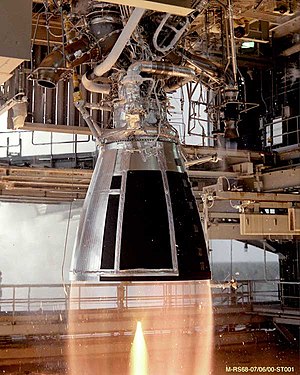RS-68A

An RS-68 engine undergoing hot-fire testing at NASA's Stennis Space Center during its developmental phase.
|
|
| Country of origin | United States |
|---|---|
| Manufacturer |
Rocketdyne Pratt & Whitney Rocketdyne Aerojet Rocketdyne |
| Application | First stage engine for Delta IV rocket |
| Liquid-fuel engine | |
| Propellant | LOX / LH2 |
| Cycle | Gas-generator cycle |
| Configuration | |
| Nozzle ratio | 21.5 |
| Performance | |
| Thrust (SL) |
RS-68: 660,000 lbf (2,950 kN) RS-68A: 705,000 lbf (3,137 kN) |
| Chamber pressure | 1,488 psi (10.26 MPa) |
| Isp (vac.) |
RS-68: 410 s (4.0 km/s) RS-68A: 412 s (4.04 km/s) |
| Dimensions | |
| Length | 17.1 ft (5.20 m) |
| Diameter | 8.0 ft (2.43 m) |
| Dry weight |
RS-68: 14,560 lb (6,600 kg) RS-68A: 14,870 lb (6,740 kg) |
| Used in | |
| Delta IV | |
The Aerojet Rocketdyne (formerly Rocketdyne and later Pratt & Whitney Rocketdyne) RS-68 (Rocket System 68) is a liquid-fuel rocket engine that uses liquid hydrogen (LH2) and liquid oxygen (LOX) as propellants in a gas-generator power cycle. It is the largest hydrogen-fueled rocket engine.
Its development started in the 1990s with the goal of producing a simpler, less-costly, heavy-lift engine for the Delta IV launch system. Two versions of the engine have been produced: the original RS-68 and the improved RS-68A. A third version, the RS-68B, was planned for NASA's Ares V rocket that was later canceled.
A leading goal of the RS-68 program was to produce a simple engine that would be cost-effective when used for a single launch. To achieve this, the RS-68 has 80% fewer parts than the multi-launch Space Shuttle Main Engine (SSME). Simplicity came at the cost of lower thrust-efficiency versus the SSME: the RS-68's thrust-to-weight ratio is significantly lower and its specific impulse is 10% lower. The benefit of the RS-68 is its reduced construction cost. The RS-68 is larger, and more powerful than the SSME and it was designed to be a more cost-effective engine for an expendable launch vehicle.
The engine uses a gas generator cycle with two independent turbopumps. The combustion chamber uses a channel-wall design to reduce cost. This design, pioneered in the former Soviet Union, features inner and outer skins brazed to middle separators, forming cooling channels. Although this method is heavier, it is much simpler and less costly than the tube-wall design (using hundreds of tubes, bent into the shape of the combustion chamber and brazed together) used in other engines. The lower nozzle has an expansion ratio of 21.5 and is lined with an ablative material. The nozzle's lining burns away as the engine runs, dissipating heat. This ablative coating is heavier than other engines' tube-wall nozzles but much easier and less expensive to manufacture. The presence of carbon in the exhaust from the ablative carbon-containing inner nozzle lining can be inferred by the yellow color of the engine exhaust, unlike the SSME's nearly-transparent flame of pure hydrogen burning. The combustion chamber burns liquid hydrogen and liquid oxygen at 1,486 lbf/in2 (10.25 MPa) at 102% power with a 1:6 engine mixture ratio.
...
Wikipedia
